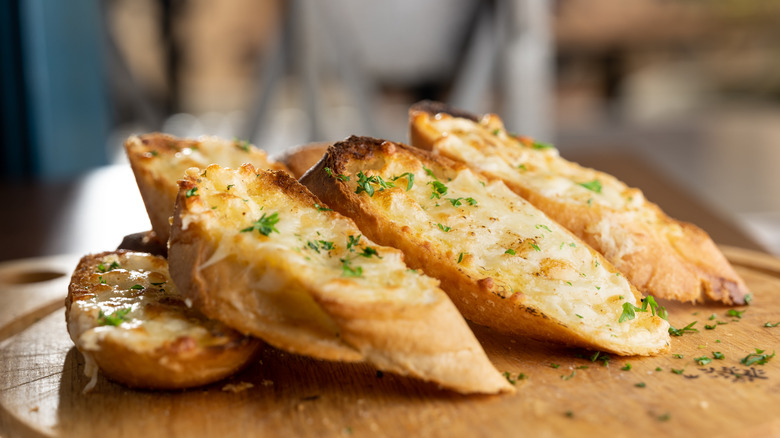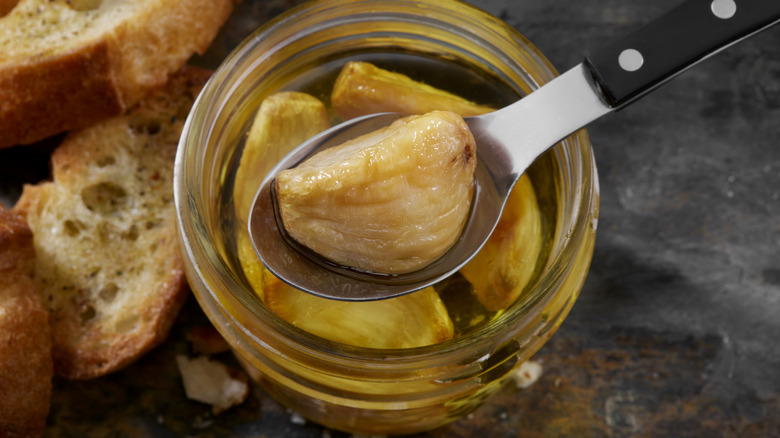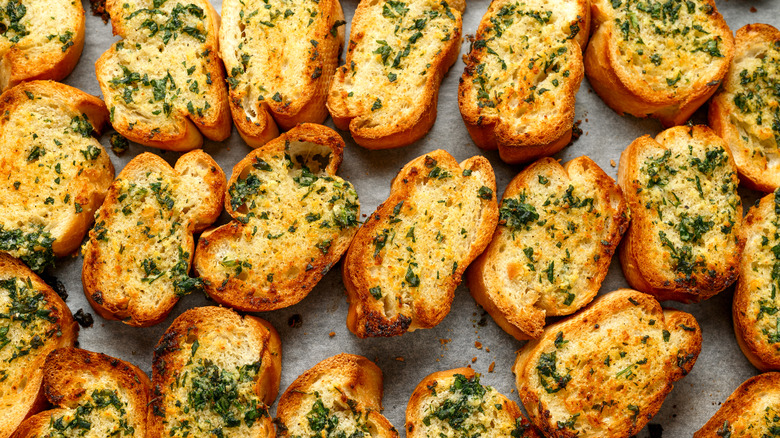The One Extra Step That'll Make Your Garlic Bread Irresistible
There is possibly no greater culinary siren song than the smell of garlic. The aroma is a secret weapon for restaurants hoping to draw in diners passing by. It can fill a home kitchen and encourage everyone to congregate around the source, hungrily waiting to taste whatever is coming out of the oven or off the stove. And there is perhaps no better way to harness and deliver that intoxicating scent than through crispy, chewy garlic bread.
Garlic is delicious in many dishes, but in this exceedingly simple preparation, it is the star of the show. While there are countless ways to get that allium's flavor on your slices of toast, one little step will take your preparation from tasty to totally irresistible — and that's to confit your garlic.
Confit your garlic cloves to transform them into a melting, spreadable, unctuous new ingredient practically engineered for ideal garlic bread. And perhaps the best part is that the process takes very little time or effort, so you won't have to wait long to dig in.
What makes garlic confit so perfect for garlic bread?
To explain why this step makes for superior garlic bread, it helps to understand what makes garlic confit unique. To confit any ingredient is to submerge it in fat and — either on the stovetop, baked in the oven, or even in the air fryer — poach it at low heat until you tenderize said item, and infuse it with big flavor while you're at it. This was historically a preservation method for everything from meats to fruit, and is still frequently used in recipes like a simple and satisfying duck confit, and other dishes that benefit from low and slow cooking.
With garlic, this method is magic for a number of reasons. For one thing, if you're sensitive to super pungent fresh garlic — or even sauteed or roasted versions — the gentle cooking process tames some of those more pronounced flavors, producing a mellow, approachable result that instead emphasizes the allium's natural sweetness.
When it comes to garlic bread, those concentrated and slightly caramelized sugars complement the toasty notes in your chosen bread, but perhaps the biggest benefit is the texture. You can literally spread garlic confit over the surface of your slices. Instead of chopped bits peppering your toast, the buttery confit cloves can work their way into every crevice.
Making your confit garlic bread
Although just two primary ingredients, you can customize your garlic confit, starting with fat selection. While many confit recipes call for olive oil, this liquid comes with its own flavor profile. A grassy, peppery, or fruity oil may be exactly what you want to complement your sweet and aromatic garlic, but if you prefer to have that allium take center stage, opt for a less assertive oil like grapeseed or safflower. You can also seek out various types of garlic for slightly different characters, as some are naturally sweeter or more peppery. You can even make garlic scape confit for a slight spin on the classic.
From there, you can lean into easy ways to add depth. Include herbs like rosemary or thyme, and throw in chili flakes or peppercorns for a kick. Just keep in mind that preserving garlic in oil can raise some food safety questions. It helps to know how to safely store homemade garlic confit so you can enjoy your creation without concern.
When creating your garlic bread with confit, if you have a crowd that clamors for cheese, broil your toast with parmesan, or even add a swipe of tangy goat cheese and garnish with herbs like mint or basil. For a protein boost, salty anchovy fillets are an ideal complement to the sweet garlic, and a little tomato can bring bright acidity. That said, you can also simply spread your confit cloves and serve, allowing your allium to shine.


